Plastination Project
In January 2018, the Fascia Research Society, Somatics Academy, the Plastinarium, and Body Worlds embarked on a new collaborative journey to create the world‘s first, 3D Human Fascia Plastinates. Together, they are creating history as the Fascial Net Plastination Project. Directed by fascia research scientist Robert Schleip, professor of anatomy Carla Stecco, with the assistance of clinical anatomist John Sharkey, the project is taking place in Guben, Germany at the world-famous Plastinarium with director Dr. Vladimir Chereminskiy. The first ten plastinated specimens from this project were exhibited for the first time at the Fifth International Fascia Research Congress in Berlin, Germany, November 14 and 15, 2018 in Fascia in a NEW LIGHT: The Exhibition. Future exhibitions are being planned. The Human Fascial Net Plastination Project is featured in the September/October 2018 issue of Massage & Bodywork magazine on pages 62-71 and 115-118. You can view the entire issue HERE for free in exchange for your name and email. Continuing updates on the project will be added here. So stay tuned!
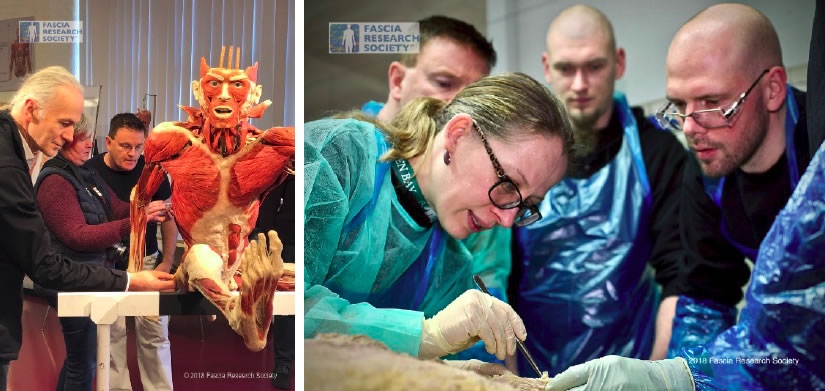
Left: Project Director Robert Schleip inspects the iliotibial band of a hurdle-jumping plastinatate in the Plastinarium Exhibit Hall along with clinical anatomist John Sharkey and team member Tracey Mellor. Photo by Rachelle L Clauson. Right: Orthopedic surgeon and professor of human anatomy and movement sciences, Carla Stecco demonstrates insights in the Plastinarum Lab. Photo by Stefan Westerback.
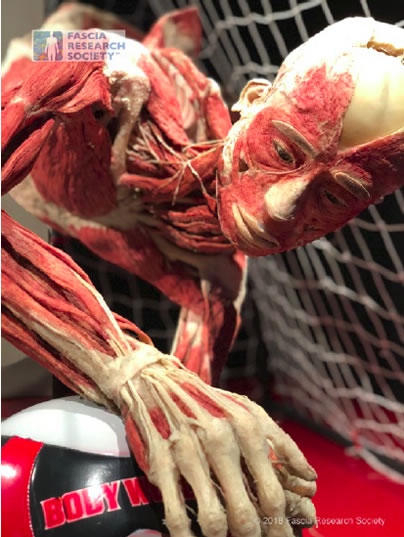 Plastination is the groundbreaking method of halting decomposition and preserving anatomical specimens for study and education which was first developed in 1977 by German Anatomist, Dr. Gunther von Hagens. A revolutionary method of cadaver tissue preservation, plastination permanently infuses the tissue with plastic polymers enabling it to be viewed, touched and studied with a level of detail and durability that was previously impossible. This method for displaying human anatomy for study and education grew to world fame and recognition through the Body Worlds international touring exhibitions.
Plastination is the groundbreaking method of halting decomposition and preserving anatomical specimens for study and education which was first developed in 1977 by German Anatomist, Dr. Gunther von Hagens. A revolutionary method of cadaver tissue preservation, plastination permanently infuses the tissue with plastic polymers enabling it to be viewed, touched and studied with a level of detail and durability that was previously impossible. This method for displaying human anatomy for study and education grew to world fame and recognition through the Body Worlds international touring exhibitions.
By creating a way to permanently preserve human bodies, and then placing them in familiar postures of everyday life that highlight their complexity and beauty, the Body Worlds exhibitions opened a doorway into the secret world of human anatomy. These exhibitions make real human anatomy, previously only viewable in the dissection lab, now available and approachable to anyone.
The field of fascia research has undergone remarkable expansion and growth in the last decade, which is shaping the progression of many related fields. The visual illustration of fascia is also expanding in order to further support fascia anatomy education. The Human Fascial Net Plastination Project was formed with the lofty goal to produce a full-body plastinate to show the entire human fascial net, three-dimensionally. Because the Plastinarium has never attempted this before, the ambitious three-year project is being approached in stages. Beginning with several smaller specimens of superficial fascia/ subcutaneous tissue and deep fascia structures, the team is learning first how the plastination process affects fascia in isolation when separated from its neighboring tissue of muscle and bone. These first plastinates were exhibited to the public at the Fifth International Fascia Research Congress November 14-15, 2018 in Berlin, Germany. The Plastinarium team is continuing to work to create the larger, full-body fascia plastinate over the course of three years, with the plan to exhibit it at the Sixth International Fascia Research Congress in 2021, and then display the plastinate as a permanent part of the Body Worlds exhibitions.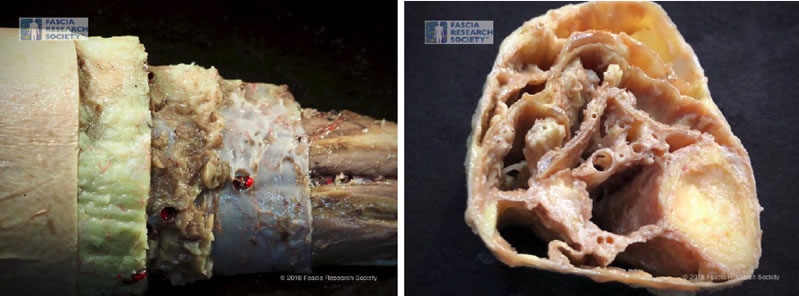
Left: Prosection of a stepped specimen of the leg revealing the layers from the skin down to the muscles. Photo by Stefan Westerback. Right: Prosection of a 5cm cross-section of the leg with the skin, supercial fascia/ subcutaneous tissue and muscle tissue removed revealing the fascia cruris, septa, and epimysial fascia. The tibia, bula and vasculature is also visible. Photo by Rachelle L Clauson.
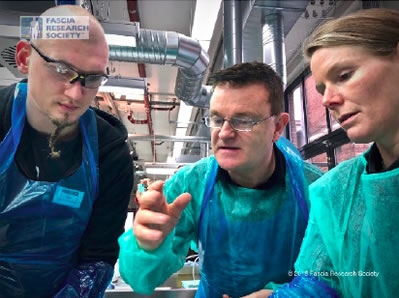 The first phase of the project began in January 2018 with a small team of scientists, academics, professors, bodyworkers, movement educators, and anatomy enthusiasts from around the world. Several formalin-fixed specimens were dissected in order to illustrate fascial structures from the superficial fascia/ subcutaneous tissues including from the abdomen, the arm, and the lower limb. Additionally, several deep fascia structures were dissected including the fascia lata, a 5cm cross-section of the thigh, a 5cm cross-section of the leg, the fibrous pericardium with respiratory diaphragm, and the lumbodorsal fascia. A unique stepped specimen was also created to demonstrate the distinctions in fascial layers from the skin to the bone.
The first phase of the project began in January 2018 with a small team of scientists, academics, professors, bodyworkers, movement educators, and anatomy enthusiasts from around the world. Several formalin-fixed specimens were dissected in order to illustrate fascial structures from the superficial fascia/ subcutaneous tissues including from the abdomen, the arm, and the lower limb. Additionally, several deep fascia structures were dissected including the fascia lata, a 5cm cross-section of the thigh, a 5cm cross-section of the leg, the fibrous pericardium with respiratory diaphragm, and the lumbodorsal fascia. A unique stepped specimen was also created to demonstrate the distinctions in fascial layers from the skin to the bone.
Prosection of these pieces was completed in five days after which they went through the first two stages of four to become plastinates. In stage one they were soaked in several high and low temperature baths which replaced the water with acetone and dissolved the fats. In the second stage the specimens were soaked in another bath that replaced the acetone with plastic polymer. These two stages typically take up to six months depending on the size of the specimen.
In June 2018 the team returned to Guben for three short days with a few more members to take the specimens into their third stage: positioning. Now slightly gooey, but fully infused with silicone rubber, the specimens were still supple and able to be positioned back into their original shape. The team created forms to support the soft specimens so they could go through the fourth and final stage of gas curing which would harden them into durable plastinates ready for exhibition.
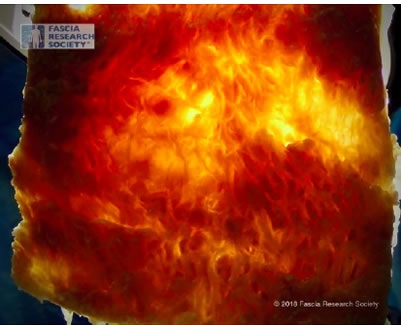 Supercial fascia/ subcutaneous tissue of the abdomen after it has gone through the rst phases of plastination. Back-lighting reveals the fascial organization. Fully infused with silicone rubber, it is ready for the nal phase of gas-curing to harden it. Photo by Rachelle L Clauson.
Supercial fascia/ subcutaneous tissue of the abdomen after it has gone through the rst phases of plastination. Back-lighting reveals the fascial organization. Fully infused with silicone rubber, it is ready for the nal phase of gas-curing to harden it. Photo by Rachelle L Clauson.
While the first team was busy with positioning, the new team members worked on several additional dissection projects for possible future plastination. A second attempt at the lumbodorsal fascia, a 10cm cross-section of the abdomen highlighting the layers of the abdominal fascia ring, the deep fascia of the arm, and an anterior, frontal prosection of the pelvis from mid-thigh to an inch above the ASIS. It was decided to model this dissection in the style of 19th century French anatomist Jean Baptiste Marc Bourgery, which involved hollowing out of the fascial sleeves, the epimysium, of the muscles on one side while leaving the other side intact.
The third phase of the project is the most ambitious with the goal of creating a full-body fascia plastinate in time for exhibition at the Sixth International Fascia Research Congress in Montreal, Canada, 2021. The plastination team will have to make many complex decisions of how best to dissect and display the fascial structures in a meaningful and understandable way. If successful, after its debut at the Sixth International Fascia Research Congress in 2021, the full-body fascial plastinate will become a permanent part of the Body Worlds exhibitions.
The Human Fascial Net Plastination Project Exhibition debuted November 14-15, 2018 at the Fifth International Fascia Research Congress in Berlin, Germany. Delegates who registered for the Congress had access to the exhibit. Members from the project were present throughout the event to discuss the pieces and share their experiences on the project.
This great achievement in fascial anatomy illustration is another step forward in education for this forgotten tissue. Not more important than its more famous cousins of muscle, vasculature, nerves, organs, and bones, fascia fills a missing piece in the story of what we are made of, and how we feel and move.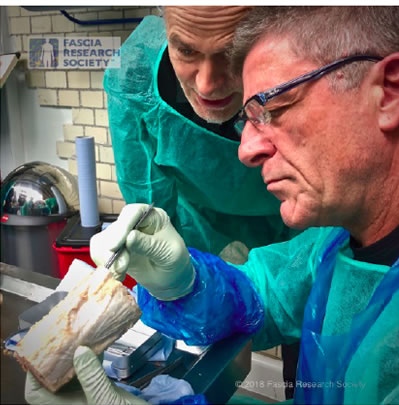 Though a huge step forward, demonstrating fascia through plastination still only tells part of the story, however. Every illustration, prosection, drawing, or illumination can only show you fascia in part. In reality, the human fascial net is a unified, continuous structure that fully wraps, envelopes, and penetrates every part of the human form down to the cellular level. In every attempt to isolate it, we lose its essence as a continuous net. As Jean-Claude Guimberteau writes in his book, Architecture of Human Living Fascia (Handspring, 2015), "Connective tissue is, in fact, the constitutive tissue. It does not only link the different parts together—it is the frame in which the parts are developed."1
Though a huge step forward, demonstrating fascia through plastination still only tells part of the story, however. Every illustration, prosection, drawing, or illumination can only show you fascia in part. In reality, the human fascial net is a unified, continuous structure that fully wraps, envelopes, and penetrates every part of the human form down to the cellular level. In every attempt to isolate it, we lose its essence as a continuous net. As Jean-Claude Guimberteau writes in his book, Architecture of Human Living Fascia (Handspring, 2015), "Connective tissue is, in fact, the constitutive tissue. It does not only link the different parts together—it is the frame in which the parts are developed."1
This does not mean that we should stop learning from dissection or plastinates. Even through separation, we can learn about connections. Just remember the real deal is the one you see in the mirror each morning -- one continuous, seamless, connected form.
Project director Robert Schleip observes as Johannes Freiberg uses tweezers to painstakingly remove the muscle tissue from the epimysial wrappings and septa in this 10cm cross-section of the leg. (It was later divided into two 5cm cross-sections to speed the process.) Photo by Rachelle L Clauson.
Note: 1. Jean-Claude Guimberteau, Architecture of Human Living Fascia (Handspring, 2015): 172.
The FNPP is a collaboration of the Fascia Research Society, Somatics Academy, the Plastinarium, and Body Worlds.
The Fascial Net Plastination Project is directed by Dr. Robert Schleip and Prof. Carla Stecco, with assistance from John Sharkey MSc, in cooperation with, Prof. Gunther von Hagens, Rurik von Hagens, Dr. Angelina Walley, Dr. Vladimir Chereminskiy, Daniela Seifert, Tilo Heinrich, and Rico Nitsche. The FNPP Committee includes Dr. Robert Schleip, Prof. Carla Stecco, Dr. Vladimir Chereminskiy, Anita Boser and Rachelle L. Clauson. Academic supervision is provided by Romed Hoermann, Tuulia Luomala, Irina Mischewski, and Mika Pihlman. Special thanks go to the Scientific Advisory Board of Dr. Ekkehard Geipel, Gil Hedley PhD, Prof. Werner Klingler, Dr. Hanno Steinke, and A/Prof. Ming Zhang; external scientific advisors Jaap van der Wal Phd, Prof. Rainer Breul, and Prof. Magdalena Mueller-Gerbi. and the remarkable volunteer team who have come together to offer their skills, talents and time including Jihan Adem, Ali AlMarzouq, Einat Almog, Eryn K Apanovitch, Cíntia Báril, Gary Carter, Tjasa Cerovsek Landes, Anthony Chrisco, Rachelle L. Clauson, Alison Coolican, Walter Dorigo, Libby Eason, Eric Franklin, Johannes Freiberg, Markus Friedlin, Andreas Haas, Beverly Johnson, May Kesler, Cosmina Krieger, Elizabeth Larkam, Tuulia Luomala, Tracey Mellor, Bernd Machel, Fauna Moore, Divo Mueller, Alexandra Müller, Sivan Navot, Laurie Nemetz, Jo Phee, Francesca Philip, Mika Pihlman, Bruce Schonfeld, Yap Poh Sim, Alison Slater, Gina Tacconi-Moore, Joel Talsma, Stefan Westerback, and Adrian Woolley. The Exhibition Committee includes Gary Carter, Rachelle L. Clauson, Tjasa Cerovsek Landes, Lauri Nemetz, Stefan Westerback and OtoCast. Thank you!
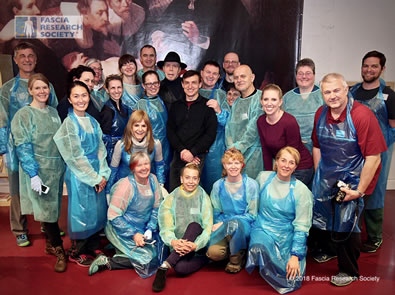
The January 2018 Team. Left to right, back row: Johannes Freiberg, Jihan Adem, Libby Eason, Fauna Moore, Andreas Haas, Gunther von Hagens, John Sharkey, Rico Nitsche, Francesca Philip, Adrian Woolley, Joel Talsma. Middle row: Alison Coolican, Jo Phee, Tjasa Cerovsek Landes, Cíntia Báril, Carla Stecco, Vladimir Chereminskiy, Gary Carter, Rachelle L Clauson, Stefan Westerback. Front row: Tracey Mellor, Elizabeth Larkam, Beverly Johnson, Divo Mueller.
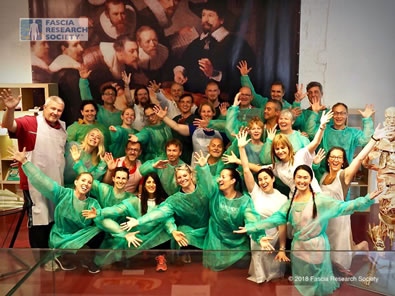
The January 2018 Team. Left to right, back row: Bruce Schonfeld, Mika Pihlman, Robert Schleip, Tilo Heinrich, Bernd Michel, Andreas Haas, Johannes Freiberg. Third row: Stefan Westerback, Jihan Adem, Lauri Nemetz, Carla Stecco, Vladimir Chereminskiy, Tuulia Luomala, Anthony Chrisco, Tracey Mellor, Eric Franklin. Second row: Elizabeth Larkam, Walter Dorigo, Markus Friedlin, Gary Carter, Beverly Johnson, Cíntia Báril, Birgit Frank. First row: Rachelle L. Clauson, Tjasa Cerovsek Landes, Einat Almog, Gina Tacconi-Moore, Alison Slater, Sivan Navot, Jo Phee.
